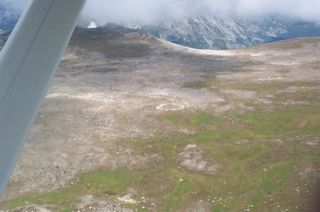
Mystery of Huge Stone Circle Solved

Scientists flying over British Columbia's mountains spotted something on the ground that made them do a double take: an odd, and large, circle of stones.
The stones were found in the Chilcotin Range of British Columbia. From above, the stones look like a giant campfire circle. Upon closer inspection, however, the team discovered that the stones were deposited by glacial activity.

The stones are called felsite rocks, which contain a lot of silica. The stone circle is about 164 feet (50 meters) across. In aerial photos, a clear circle of rocks is seen above the tree line, and they stand out from the other types of rocks in the area, reported EarthSky. The circle is even visible on Google Earth.
Other large stone circles — mostly found in Europe — date to prehistoric times, and are believed to have been for religious ceremonies. But due to the lack of similar stone circles in the region and the low likelihood that people wandered these parts when the stone circle was formed, scientists concluded that it was not man-made.
Other signs of human activity were not seen, such as smaller stones stacked upon larger stones in the circle, thought to be a common feature of stone circles created by humans, according to the scientists.
The stone circle was likely created by deglaciation, when huge ice sheets retreated from the region, the scientists said. These retreating ice sheets moved rocks and debris that are sometimes deposited in circles. Debris is known to slide down cones of unmelted ice to form a circle on the ground, according to EarthSky, although the circle in British Columbia is unusually large.
You can follow OurAmazingPlanet staff writer Brett Israel on Twitter: @btisrael. Follow OurAmazingPlanet for the latest in Earth science and exploration news on Twitter @OAPlanet and on Facebook.
Sign up for the Live Science daily newsletter now
Get the world’s most fascinating discoveries delivered straight to your inbox.
Most Popular

